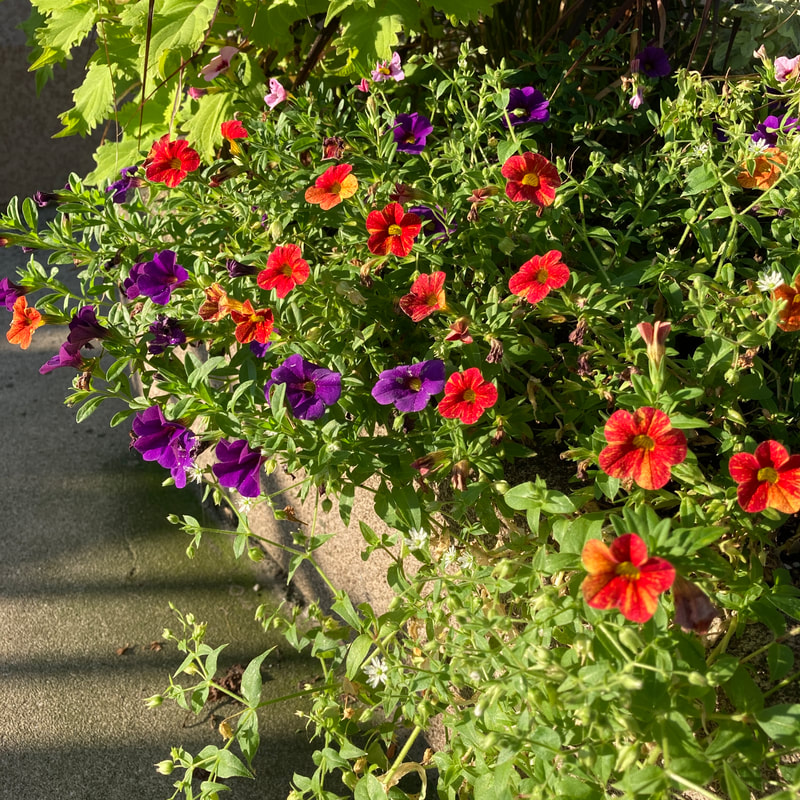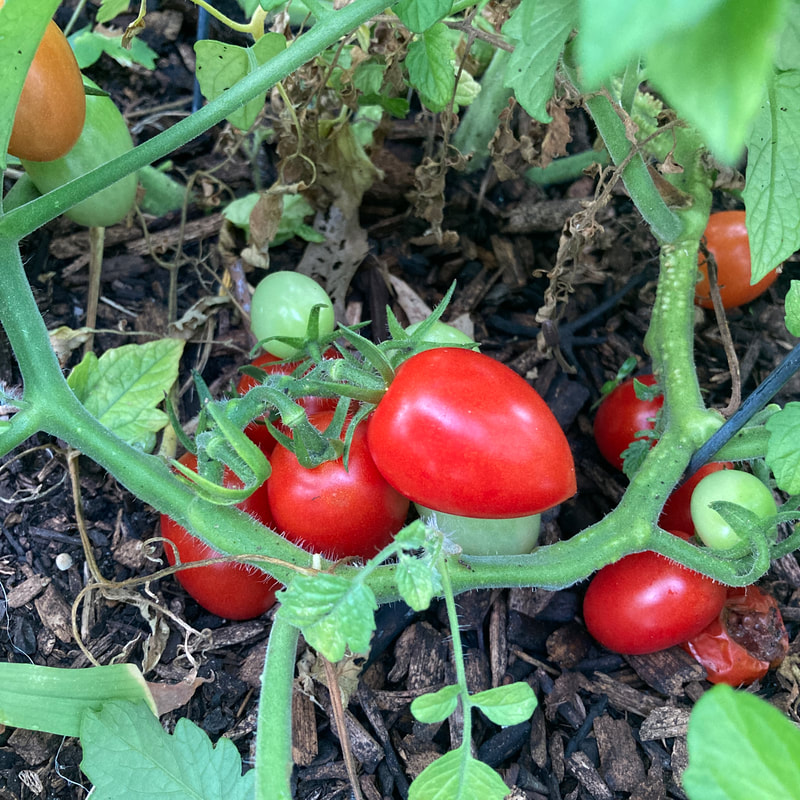|
Photo and article by Donna Iverson Surprisingly, the white water lily, like those found in Michigan, are native to North America. You can find them all over the state including the UP. They are most often found in local creeks, shallow ponds and wetland areas. The America water lilies pictured above bloom every summer in the Monet Garden in Muskegon, creating a vision of peace and tranquility during troubled times. A perennial, hardy water lily (Nymphaea odorata) can survive our winters if their roots are plants below the frost line. They need four to six hours of direct sun. Their white sweet-scented flower blooms are huge and last about four days, flowering from May through September. Once planted, water lilies last from fifteen to twenty years. Water lilies are good for the environment. They keep the water cool and prevent algae, actually oxygenating it. They provide shelter for fish from both birds and the sun. Beavers, ducks and deer feed on their leaves. The entire water lily is also safe for humans to eat, including the flowers, seeds, shoots, and rhizomes. It can be eaten raw or cooked with the bulb (rhizome) most nutritious, tasting to some like a sweet potato. The rhizome outer rind should be peeled before eaten. The water lily has also been used medicinally to treat diarrhea and inflammation. Always test a small piece for individual allergies. A close relative of the water lily is the American lotus (Nelumbo lutea). Like the water lily it is edible but invasive. Mostly found along the Mississippi River, the flowers of the lotus are yellow. The American lotus can easily be distinguished from our native water lily by the leaves. The water lily has a large notch while the edge of the lotus is smooth. For information on how to grow and care for water lilies, check out https://www.thespruce.com/the-incomparable-waterlily-and-lotus-1403525
0 Comments
Plant Swap, Book Discussion, The Return of Storytime & More
The Fremont Area District Library is planning to host several fun and educational programs in September for the whole family. All of the following events are free. Laurie Platte Breza, MSU’s 4-H Coordinator, will be at the library on Tuesday, September 20th at 6:00 p.m. in the Community Room to teach and present on the topic of Beginning Flower Gardens. Come to learn, plus you can bring a plant if you’d like to participate in a plant swap! Fit for Life exercise class will return on Mondays and Wednesdays in September, beginning September 7th, from 12:00-1:00 p.m. Fit for Life is a functional movement class designed to move the whole body through a series of seated and standing exercises that will increase strength, muscular endurance, balance, and flexibility. Class is low impact and great for ALL levels of fitness who are interested in working on their overall health. Junk Journaling will now be meeting at a new time; between 6:00-8:00 p.m. The next Junk Journaling class will take place in the Community Room on September 8th. This is a scrapbooking and journal hybrid. Use up what you have and supplement with found, recycled, repurposed and thrifted items. For ages 10 and up. Materials provided. We’re bringing back Storytimes from August 31st-December 1st. Toddler Storytime, for babies and toddlers up to age 3, will be held on Wednesdays at 10:00 a.m., and Family Storytime for children up to age 5 will be held on Thursdays at 10:00 a.m. Puzzle Saturday returns on September 10th from 10:00-1:00 p.m. We'll have some puzzles and games out in the kids’ area that you can enjoy and try to complete. We’ll also be showing a family-friendly Afternoon Movie (title to be determined) on Thursday, September 22nd at 3:30 p.m. Check with the library for movie details. Snacks will be served, and all are welcome. Saturday Storytime, for children up to age 5 will be on September 24th at 11:00 a.m. in the Community Room. Our new Non-Fiction Book Discussion group will meet on September 19th at 6:00 p.m. by the north fireplace to discuss Killers of the Flower Moon by David Grann. N3 note: For an interesting take on the book check out Charles Chandler’s review of the book from a few years back. https://www.nearnorthnow.com/the-pulse/book-review-killers-of-the-flower-moon The Wednesday Readers Book Group will meet on Monday, September 12th at 7:00 p.m. to discuss Educated by Tara Westover, and the Daytime Book Group will meet on Thursday, September 22nd at 12:30 p.m. to discuss The Widows of Malabar Hill by Sujata Massey. Anyone is welcome to join these book groups. Books for these groups are available at the library’s front desk ahead of the meeting if you’d like to check out a copy and join the group. For more information about any of these events, please contact the library at 231-924-3480 or visit www.fremontlibrary.net. Calibrachoa
Photo and article by Donna Iverson No one seemed to know the name of the flowers that looked like a tiny petunias. Yet they were everywhere ..in hanging baskets, window boxes, raised beds and along garden edges. They were multicolored, in shades of red, yellow, orange, pink, blue, purple and cream ..often in the same hanging basket. Searching the internet on the term “tiny petunias” turned up the plant’s name: Calibrachoa. No wonder no one knew their name. Further research revealed that they are also called “million bells” a name which has been trademarked. An annual, Calibrachoa flowers look like tiny petunias and last through the summer and into the fall. Their sticky leaves and colorful flowers attract both butterflies and hummingbirds. Deer aren’t fond of them although they are not listed as deer resistant. Six to twelves inches in height, they are native to South America. Calibrachoa can be grown from seed or cuttings. But it is technically illegal to propagate them from cuttings because their name is trademarked. They are mostly easily grown by purchasing them from nurseries. In late summer, it helps to cut them back and administer a dose of slow-release fertilizer. So is Calibrachoa related to the petunia? At one time, they were classified as the same genus, but they have been since separated into two plant families ..Calibrachoa and the petunia genus. Review by Amy Martin, Fremont Area District Library Circulation Supervisor I waited to read this adult series about the Fae until it wasn't quite so popular and I had a lot of time I could devote to reading it. This is the story of Feyre, a human huntress from a poor family who kills a wolf that is actually a fae, and is brought into the fae world of Prythian as a consequence. She is brought there by Tamlin, High Lord of the Spring Court, and is thrown into a huge fight for all of the fae lands and then skirmishes with human queens when the wall between the fae and humans is brought down. Feyre, along with her sisters, Nesta and Elain, end up losing their humanity and being transformed into fae. Along the way, Feyre meets Rhysand, High Lord of the Night Court and they find that they are fated mates. Along with Rhysand, comes a great group of characters, his long-time friends Cassian, Azriel, Mor, and Amren. I found that the friendship between all these characters made for a very rewarding reading experience. The villains in this series were awful to their foes, as villains should be. Feyre and her sisters also have many spats and learning experiences along the way. Nesta in particular is a fierce character, and in the final book so far, A Court of Silver Flames, has an awesome transformation to a better, more complex character. I notice that Sarah J. Maas left an opening for Elain's story to be told, so hopefully sometime soon she will write and publish that. I think that is the only thing I really was missing from this series--the feeling that it's not at an end. Put the books in this series on hold: 1. A Court of Thorns and Roses https://bit.ly/3BXaQAk 2. A Court of Mist and Fury https://bit.ly/3dlQ2IJ 3. A Court of Wings and Ruin https://bit.ly/3dmyUCp 3.1 A Court of Frost and Starlight https://bit.ly/3SAqUOB 4. A Court of Silver Flames https://bit.ly/3JO92Mg Photo and article by Donna Iverson A small group of tomatoes are named after fruits including cherry tomatoes, plum (Roma) tomatoes and grape tomatoes. But then technically, tomatoes are a fruit. Grape tomatoes have been around since 1996 when they were first grown in Florida. Today, they outsell cherry tomatoes 10 to 1. They came to America from Taiwan, where they were developed as a hybrid variety. Cherry tomatoes, on the other hand, are native to South America. But they are losing out to grape, which are sweeter, larger, meatier, and can be stored longer. Recently, I asked a fellow community gardener why she switched from cherry tomatoes to grape tomatoes this summer and she said “because I can just pop them into my mouth.” “But you can do that with cherry tomatoes,” I protested. “I did that last year,” she replied. My takeaway is that grape tomatoes have a lot of novelty appeal. As well as growing them yourself, you can find them for sale at farmers markets and supermarkets, where their shelf life is longer than cherry tomatoes. Because of their thicker skin, they also ship better without bruising. From time of picking to eating, they remain fresh around five days. Like all tomatoes, grape tomatoes are highly nutritious with impressive amounts of lycopene, Vitamins A and C. Six bite size tomatoes equal a serving. If you want to grow them yourself, seedlings should be planted in early June in full sun and in rich soil. Water every two or three days, or daily during a drought. Your grape tomatoes will likely all open at the same time with yields of about 20 to 90 grape tomatoes per plant. Once the diminutive tomatoes appear, they will take 20 to 30 days to ripen. Like all tomatoes, people with acid reflux, histamine intolerance and kidney stones should limit their daily intact to small amounts. While red is the most popular color, grape tomatoes come in orange, yellow, brown, and pink. Popular varieties include: Tomato Bronze, Gold Spark, Red Candy, Red Grape and Sweet Hearts. The Fremont Area District Library will continue to offer fun and educational events this summer. Just a reminder that children can continue turning in their reading logs for the Summer Reading Program and collect their prizes until the end of August. Summer Reading has wrapped up for adults and teens. Here’s what’s coming in August:
|
Archives
July 2024
Categories |






 RSS Feed
RSS Feed